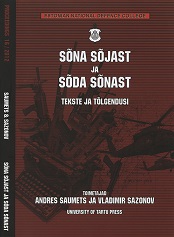Küüditamis- ja terroripoliitika Kesk-Assüüria ja Uus-Assüüria impeeriumides 13.-7. sajandil eKr.
The Deportation and Terror Policies of the Middle-Assyrian and Neo-Assyrian Empires in the 13th-7th Centuries BC
Author(s): Vladimir SazonovSubject(s): History
Published by: Kaitseväe Ühendatud Õppeasutused
Summary/Abstract: This article is dedicated to the complicated question of the widespread policy of deportation in the Middle-Assyrian and Neo-Assyrian Empires from the 13th to the 7th century BC. Deportations began in Assyria already in the Middle-Assyrian period in the 13th century BC, but were irregular. Only later during the 9–7th centuries did deportation become a regular feature of the terror and assimilation policies of the kingdoms. The Neo-Assyrian Empire that was established in the 9th century BC may be regarded as a classical example of an early totalitarian state that employed the methods of totalitarian rule, such as mass deportation, assimilation, physical and psychological terror, torture (impaling, for example), cruel executions, mass murders and other methods of genocide, and etc. After the successful end of a military campaign or the suppression of a rebellion, Assyrian kings often ordered that cities and villages be burnt and citizens be deported or killed in order to punish or humiliate a conquered people or country. The idea of deportation is certainly much older – some Sumerian and Old Akkadian kings in Mesopotamia already made use of it in the III millennium BC (e.g. Rimuš of Akkad who ruled in the 23rd century BC, and etc.) deported some groups of peoples from conquered territories, but it was not a common political method. Deportation was also used by the Hittite and Babylonian kings during the II millennium BC. But only the Assyrians made common the use of mass deportation and murder in order to establish their hegemony over the whole near eastern area or “universe”, in the understanding of ancient Mesopotamians. This took place relatively late – at the beginning of the I millennium BC. The Assyrian kings deported hundreds of thousands or even millions of people; hundreds of thousands of others were killed, or tortured. Many cities and villages were looted, razed, or burned. Probably 2-3 or even 5–6 million people of the population of ancient Near East were deported over a period of 200–250 years – during the so-called period of hegemony of Assyria. These numbers are of course quite hypothetical, as is the number of those who were killed or tortured during the Assyrian wars or by the order of brutal Neo-Assyrian kings, but the number is in the hundreds of thousands or even millions of people. It can be concluded that all, or almost all, of the neo-Assyrian kings actively incorporated this policy into their state political system and drew upon it quite often to terrorize the conquered peoples of ancient Near East and to put down any separatist action, such as revolt, and etc. The early totalitarian Assyrian empire with its despotic regime was one of the cruelest regimes in the history of mankind. These policies of course preserved the imperial stability and kept the empire from collapse, but also had a very negative influence on the population, the economy and also on the demography.
Journal: KVÜÕA toimetised
- Issue Year: 2012
- Issue No: 16
- Page Range: 180-202
- Page Count: 23
- Language: Estonian

